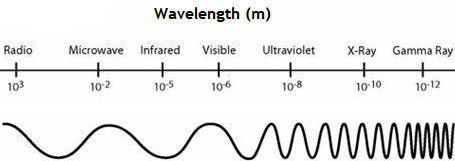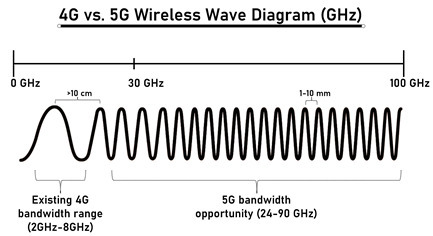Top 5G Antenna Manufacturers and Suppliers in the USA and Globally
Share:

5G technology promises faster speeds, more reliable connection, and an overall better wireless experience, but what is 5G technology, and how does it work? Also, why do we need to update our wireless antennas to meet the needs of 5G?
What is 5G?
All wireless technology works via electromagnetic (EM) waves or oscillations of electric and magnetic fields that propagate through space. The length of a given wave (known as its wavelength) is defined by the distance between two peaks (Figure 1 below illustrates various wavelengths across the electromagnetic spectrum).
[caption id="attachment_3522" align="aligncenter" width="455"] Image credit: http://labman.phys.utk.edu/[/caption]
Image credit: http://labman.phys.utk.edu/[/caption]
Figure 1: The electromagnetic (EM) spectrum. Notice how, as wavelength decreases, frequency increases.
Current wireless technologies use wavelengths between radio frequency and microwave frequency, as this range is non-ionizing and capable of traveling long distances. As the wavelength decreases, so does its transmittable distance; however, its frequency increases, allowing for more information to be sent per unit of distance. Figure 2 shows the typical frequencies of 4G vs. 5G waves:
[caption id="attachment_3523" align="aligncenter" width="433"] Image credit: Christian Cavallo Consulting, LLC[/caption]
Image credit: Christian Cavallo Consulting, LLC[/caption]
Figure 2: 4G vs. 5G frequency differences. Notice how current wireless technologies implement a small, lower frequency range when compared to the 5G bandwidth range. (Note: the waves in Figure 2 are not scaled to the wavelengths in Figure 1).
5G (or fifth generation) technology is the evolution of 4G (fourth generation) technology and uses these denser waves, allowing for faster data transmission. 5G networks implement millimeter wavelengths (or millimeter waves), while the current 4G technology uses waves with tens of centimeters-long wavelengths. These millimeter waves can be packed with more information but also can only travel much shorter distances. Therefore, while 5G promises more information delivered with its higher frequency signals, it will also require a fundamental shift from the traditional cellular antenna to smaller, more widely dispersed antenna networks.
What are 5G antennas?
5G antennas are wireless nodes that can handle the increased data transmission rates and energy output of 5G signals. They differ from traditional 4G towers in that they are highly directional, meaning there must be a line of sight with a 5G antenna for connection to occur. 5G antennas are much smaller than typical wireless antennas and are designed to fit onto telephone poles, buildings, inside rooms, and even under desks. 5G antennas are less power-hungry than 4G antennas, as they can turn off antennas in low-traffic areas, whereas a 4G tower would have to radiate waves to that area regardless of traffic. 5G antennas can also support over 1000 more devices per meter than their 4G counterparts, reducing latency and increasing precision.
5G antennas are not all built the same; due to the increased frequency range, 5G technology benefits from a so-called multi-layer spectrum. Depending upon the application, specialized antennas are used to optimize the specific range of frequencies employed. For example, signals in the 6-10 GHz range can somewhat penetrate objects, making them more useful for environmental monitoring, transportation, and smart city applications. Waves beyond 24 GHz, while non-penetrating, are perfect for machine-to-machine (M2M) communication and direct connections. Each of these ranges will require two different 5G antenna types, each with different form factors and power requirements.
Internal antennas for wireless devices must also be updated to receive the full benefits of 5G. These components are typically chipsets that transmit incoming and outgoing wireless signals, converting them into useful data for the device (this could be video information, text, etc.). These components, while smaller than networking antennas, are needed to ensure that devices can handle the increased bandwidth of information from 5G service providers.
What are 5G antenna manufacturers and suppliers?
5G antenna manufacturers and suppliers provide 5G antennas to customers. This area of manufacturing is still new, meaning there are many small companies designing antennas in expectation of an increase in demand (however, established companies are also throwing their hats into the ring). These manufacturers design, test, and build 5G antennas for specific applications, installing them into your network and optimizing them depending on specifications. They implement technologies such as multiple-input-multiple-output (MIMO) and beamforming methodology to enhance connectivity with reduced power usage. 5G antenna manufacturers will ensure that their products tie into existing 4G networks without interference and that the new 5G network is validated for use.
This article will explore the top featured 5G antenna manufacturers and suppliers on Thomas, as well as the top suppliers in the USA and globally.
Top Featured 5G Antenna Manufacturers and Suppliers on Thomas
Table 1 below lists the top featured manufacturers and suppliers of 5G antennas on Thomasnet.com. Included in the information, you'll find details on each company's location, year founded, number of employees, and brief summary of activities.
Table 1: Top Featured 5G Antenna Manufacturers and Suppliers on Thomas
| Company | Location | Year Founded | Employee Size |
| Win Source Electronic Technology Ltd. | Spokane, WA | 1999 | 200-499 |
| Tekdis | Fremont, CA | 2005 | 10-49 |
| ZenFi Networks | NY, NY | 2013 | 50-99 |
| Anokiwave | San Diego, CA | 1999 | 10-49 |
| Movandi Corporation | Irvine, CA | 2016 | 10-49 |
| Blue Danube Systems | Santa Clara, CA | 2006 | 50-99 |
Top Featured 5G Antenna Manufacturers and Suppliers on Thomas— Company Summaries
Win Source Electronic Technology Ltd. is a distributor that supplies the automotive, electronics, medical, energy, and aerospace sectors with obsolete and end-of-life electronic parts and components such as integrated circuits, sensors, semiconductors, connectors, transducers, relays, resistors, filters, and cables. The company is located in Spokane, WA, and has been in business since 1999.
Tekdis is a distributor that supplies the gaming, mining, medical, automation, and transportation industries with industrial computing, RF, and display products including displays, digital signage, computers, 5F and LTE gateways, panels, cameras, and memory modules. The company has its headquarters located in Fremont, CA, and has been in business since 2005.
ZenFi Networks is a turnkey systems integrator that specializes in fiber optic networks and towers. It also offers both 4G and 5G short-range antennas and network edge colocation centers. The company has its headquarters located in NY, NY, and has been in business since 2013.
Anokiwave is a manufacturing company that provides silicone core integrated circuits for radar, 5G, and satcom applications. Its line of products includes active antenna silicon, millimeter wave silicon, and millimeter wave front-end integrated circuits. The company is located in San Diego, CA, and has been in business since 1999.
Movandi Corporation is a manufacturing company that specializes in 5G millimeter wave network equipment and systems. The company has its headquarters located in Irvine, CA, and has been in business since 2016.
Blue Danube Systems is a manufacturing firm that provides a wide range of wireless products for mobile networks. Its line of products includes single and multi-band phased array, and low-band passive antennas. Its products can be used with 4G and 5G networks. The company is located in Santa Clara, CA, and was established in 2006.
Top 5G Antenna Manufacturers and Suppliers Globally
This table contains relevant information on the top 5G antenna manufacturers and suppliers, as determined by ResearchAndMarkets.com’s global 5G antenna market report. Additional details about each company are included such as headquarters location, the number of employees, year founded, estimated annual revenue, and brief company summaries. Dashes indicate where information was unavailable, and international revenues were adjusted to U.S. dollars using exchange rates as of February 4, 2021.
Table 2: Top 5G Antenna Manufacturers and Suppliers Globally
| Company | Headquarters | No. of Employees | Year Founded | Est. annual revenue |
| Airgain Inc. | San Diego, CA | 100-249 | 1995 | $56 Million [1] |
| Samsung | Suwon-si, South Korea | 100,000+ | 1938 | $200 Billion [2] |
| Airspan Networks Inc. | Boca Raton, FL | 500-999 | 1992 | $70 Million [3] |
| Huawei | Shenzhen, China | 100,000+ | 1987 | $131 Billion [4] |
| Comba Telecom Systems Holdings Limited | Science Park, Hong Kong | 5000+ | 1995 | $730 Million [5] |
| CommScope Holding Company, Inc. | Hickory, NC | 10,000+ | 1976 | $2 Billion [6] |
| Telefonaktiebolaget LM Ericsson | Stockholm, Sweden | 50,000+ | 1876 | $25 Billion [7] |
| Fractus Antennas S.L. | Barcelona, Spain | 10-49 | 2015 | Private |
| Laird Connectivity | Akron, OH | 250-499 | 1980 | $200 Million [8] |
| Linx Technologies | Merlin, OR | 10-49 | 1997 | Private |
| Nokia Corporation | Espoo, Finland | 90,000+ | 1865 | $26 Billion [9] |
| Panorama Antennas Ltd. | Wandsworth, London | 100-249 | 1947 | $28 Million [10] |
| PCTEL, Inc. | Bloomingdale, IL | 250-499 | 1994 | $91 Million [11] |
| QUALCOMM Incorporated | San Diego, CA | 10,000+ | 1985 | $8.3 Billion [12] |
| Taoglas Limited | Enniscorthy, Ireland | 250-499 | 2004 | — |
Top 5G Antenna Manufacturers and Suppliers Globally—Company Summaries
Airgain Inc. is a leading provider of advanced antenna technology for the consumer, enterprise, and automotive industries. Airgain’s goal is to confer a minimum 30% OTA performance improvement over competing antenna systems, and they have partnered with trusted OEMs and ODMs to enhance their industrial IoT experience. Their headquarters is in San Diego, CA.
Samsung is a global multinational conglomerate based in Suwon-si, South Korea, producing a massive number of consumer electronics, networking equipment, cellular technology, and more. Samsung currently provides commercial 5G solutions for 2.5GHz up to 39GHz frequencies, all built to meet multiple deployment scenarios whether it be outdoor, in-building, or custom-mounted antennas.
Airspan Networks Inc. is a leading 4G/5G hardware and software vendor, owning an extensive portfolio of network densification products. Airspan expects to deploy its 5G networking solutions within the next two years, focusing on fixed wireless applications as well as industrial/venue settings. Their headquarters resides in Boca Raton, FL.
Huawei is a Chinese multinational telecommunications equipment and consumer electronics solutions provider. Huawei is a global leader in 5G antenna technology, providing a full line of multi-band antennas, multi-beam antennas, smarty antennas, combined, amplifiers, and other supporting components. Their headquarters is in Shenzhen, China.
Comba Telecom Systems Holdings Limited is a manufacturer of antennas and subsystems, network products, smart city solutions, and wireless transmission devices based out of Hong Kong. In 2020 Comba revealed a full range of end-to-end 5G solutions including 5G base stations, wireless access points, radio hardware, and indoor 5G network services.
CommScope Holding Company, Inc. owns a leading portfolio of networking solutions such as ERA, HELIAX, ONECELL, RUCKUS, SURFBOARD, SYSTIMAX, and other brand-name network hardware/software. Their extensive list of antennas suits nearly any deployment environment and is built with IoT and other cloud-based services in mind. Their headquarters is in Hickory, NC.
Telefonaktiebolaget LM Ericsson is the first company to launch commercial 5G networks on four continents and is a supporter of over 2.5 billion subscribers from 2G to 5G (over a third of the global population!). Ericsson is one of the leading global providers of networks, digital services, managed services, and emerging 5G, IoT, AI, VR, and edge computing technologies, and has the potential to grow into one of the largest 5G providers in the world. Their headquarters is in Stockholm, Sweden.
Fractus Antennas S.L. is a manufacturer of 5G antennas and currently owns one of the smallest 5G antennas at just over 7x3x1 mm in size. Along with their 5G cellular antennas, Fractus also provides mobile IoT, dual-band, and other internal antenna options for customers. Their global headquarters reside in Barcelona, Spain.
Laird Connectivity is a manufacturer of tailored wireless solutions for IoT, sensor optimization, cloud integration, and application development services. Laird simplifies existing wireless technology with their expert staff of engineers, who implements cutting-edge modules, antennas, integrated sensors, and more to enhance wireless capabilities in any application. Their headquarters is in Akron, OH.
Linx Technologies of Merlin, OR is a manufacturer of wireless components such as antennas, modules, remote controls, RF connectors, and more. Linx’s 5G antennas are built for cellular IoT, public safety, and private networking applications, and are offered in low-band, mid-band, high-band, and even unlicensed spectrums.
Nokia Corporation is a Finnish multinational telecommunications, IT, and consumer electronics company based out of Espoo, Finland. Nokia is responsible for launching Singapore’s first 5G services for consumers and enterprises and is expanding its portfolio to enhance its dedicated 4G networks around the world.
Panorama Antennas Ltd. is a Wandsworth, UK-based manufacturer of communication antennas for 2G, 3G, 4G, 600MHz, 700MHz, 3.5 GHz, and 5GHz 5G frequencies. Their portfolio contains numerous indoor 5G antenna solutions, as well as multifunction, wide band, and MIMO directional antennas.
PCTEL, Inc. is a manufacturer of industrial IoT devices, antenna products, test and measurement devices, and other wireless technologies. They serve agricultural, manufacturing, military, mining, public safety, transportation, wireless telecom, and more from their headquarters in Bloomingdale, IL,
QUALCOMM Incorporated is an American-based multinational corporation focusing on semiconductors, software, and wireless technology. Qualcomm pairs its mmWave antenna modules with its world-famous Snapdragon brand of modems to create a comprehensive modem-to-antenna system for customer-premises equipment. Their global headquarters resides in San Diego, CA.
Taoglas Limited of Enniscorthy, Ireland is a leading enabler of digital IoT-based wireless solutions, custom antenna design, device layout optimization, and automotive antennas. Their 5G antennas come in a variety of form factors and are perfect for sub-6-GHz and millimeter-wave frequencies, perfect for external and internal applications.
Top 5G Antenna Manufacturers and Suppliers in the USA and Globally—Summary
This article outlined the top featured 5G antenna manufacturers and suppliers on Thomas, as well as the top suppliers in the USA and globally. We hope this information has been helpful to you in your supplier search. To learn more about these companies, or to make your own custom list of suppliers, feel free to visit Thomas Supplier Discovery where we have over 768 antenna suppliers listed.
Sources
- https://www.forbes.com/
- https://www.globenewswire.com/
- https://ieeexplore.ieee.org/
- https://www.islandssounder.com/
- https://www.datanyze.com/companies/zenfi-networks/359185164
- https://www.zoominfo.com/c/movandi-corp/397821425
- https://www.crunchbase.com/
Other Top Supplier Articles
- The Top Fireworks Manufacturers and Suppliers in the USA
- Top Glass Aquarium Manufacturers and Suppliers
- Top Heat Pump Manufacturers and Suppliers
- Top Manufacturers In Memphis, TN
- Top Manufacturers In Grand Rapids, MI
- Top Houseboats Manufacturers and Suppliers
- Top Wholesale Tea Suppliers and Manufacturers
- Top Telescope Manufacturers and Suppliers
- The Top Smartphone Manufacturers and Suppliers in the USA
- The Top SIM Cards Manufacturers and Suppliers in the USA
- Top Potato Chip Manufacturers and Suppliers
- Top Compound Bow Manufacturers and Suppliers
- Top Area Rug Manufacturers and Suppliers
- Top Hurricane Window Manufacturers and Suppliers
- Top Fiber Cement Siding Manufacturers and Companies in the USA
- Top Hat Manufacturers in the USA and Worldwide
- Top Shed Manufacturers and Suppliers
- Top Watch Manufacturers and Suppliers in the USA
- Top Coffee Machine Suppliers and Manufacturers
- The Top Piano Manufacturers and Suppliers in the USA







